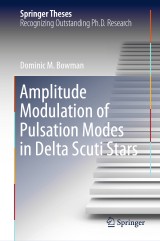Details

Amplitude Modulation of Pulsation Modes in Delta Scuti Stars
Springer Theses
|
96,29 € |
|
| Verlag: | Springer |
| Format: | |
| Veröffentl.: | 07.09.2017 |
| ISBN/EAN: | 9783319666495 |
| Sprache: | englisch |
Dieses eBook enthält ein Wasserzeichen.
Beschreibungen
This outstanding thesis by Dominic Bowman provides a thorough investigation of long-standing questions as to whether amplitude modulation is astrophysical, whether it offers insights into pulsating stars, and whether simple beating of modes with stable amplitudes is unrecognised because of a lack of frequency resolution. In this thesis, the author studied a uniform sample of 983 delta Scuti stars—the most common type of main-sequence heat engine pulsator—that were observed nearly continuously for 4 years at stunning photometric precision of only a few parts per million by the Kepler space mission. With no mission planned to supersede the Kepler 4-year data set, this thesis will stand as the definitive study of these questions for many years. With revolutionary photometric data from the planet-hunting Kepler space mission, asteroseismic studies have been carried out on many hundreds of main-sequence solar-type stars and about 10,000 red giants. It is easy to understand why those stochastically driven stars have highly variable amplitudes. Over much of the rest of the Hertzsprung–Russell (HR) diagram, stellar pulsations are driven by heat mechanisms, which are much more regular than the stochastic driving in solar-like pulsators. Yet for decades, amplitude and frequency modulation of pulsation modes have been observed in almost all types of heat-driven pulsating stars. The author shows that the amplitude and frequency modulation are astrophysical, and he has investigated their implications and prospects to provide new insights into the delta Scuti stars and the many other types of heat-engine pulsators across the HR diagram.
Introduction.- The <i>Kepler</i> Space Photometry Revolution.- The Delta Scuti Star KIC 7106205.- <i>Kepler</i> Observations of Delta Scuti Stars.- Amplitude Modulation in Delta Scuti Stars.- Characterising Pulsational Non-linearity.- Characterising Pulsational Non-linearity.- Conclusions and Future Work.
Dominic Bowman is a postdoctoral researcher at the Institute for Astronomy at KU Leuven in Belgium. His research interests include asteroseismology of intermediate-mass stars such as delta Scuti and roAp stars, and high-mass stars such as SPB and beta Cephei stars. One of his particular interests is the search and interpretation of observational signatures of internal gravity waves in stars with convective cores, which provides constraints for angular momentum transport and mixing in 3D hydrodynamical simulations. Dominc is currently involved in the asteroseismic working groups for the Kepler and TESS missions on main sequence A and F stars.
This outstanding thesis by Dominic Bowman provides a thorough investigation of long-standing questions as to whether amplitude modulation is astrophysical, whether it offers insights into pulsating stars, and whether simple beating of modes with stable amplitudes is unrecognised because of a lack of frequency resolution. In this thesis, the author studied a uniform sample of 983 delta Scuti stars—the most common type of main-sequence heat engine pulsator—that were observed nearly continuously for 4 years at stunning photometric precision of only a few parts per million by the Kepler space mission. With no mission planned to supersede the Kepler 4-year data set, this thesis will stand as the definitive study of these questions for many years. With revolutionary photometric data from the planet-hunting Kepler space mission, asteroseismic studies have been carried out on many hundreds of main-sequence solar-type stars and about 10,000 red giants. It is easy to understand why those stochastically driven stars have highly variable amplitudes. Over much of the rest of the Hertzsprung–Russell (HR) diagram, stellar pulsations are driven by heat mechanisms, which are much more regular than the stochastic driving in solar-like pulsators. Yet for decades, amplitude and frequency modulation of pulsation modes have been observed in almost all types of heat-driven pulsating stars. The author shows that the amplitude and frequency modulation are astrophysical, and he has investigated their implications and prospects to provide new insights into the delta Scuti stars and the many other types of heat-engine pulsators across the HR diagram.
Nominated as an outstanding PhD thesis by the University of Central Lancashire, Preston, UK Includes a comprehensive literature review of amplitude modulation across the Hertzsprung–Russell (HR) diagram Provides an overview of recent investigations and discoveries involving delta Scuti stars Guides the reader through the detailed analyses of space- and ground-based photometry of delta Scuti stars Includes one of the largest published catalogues of delta Scuti stars Includes supplementary material: sn.pub/extras
Nominated as an outstanding PhD thesis by the University of Central Lancashire, Preston, UK <p>Includes a comprehensive literature review of amplitude modulation across the Hertzsprung–Russell (HR) diagram </p> <p>Provides an overview of recent investigations and discoveries involving delta Scuti stars </p> <p>Guides the reader through the detailed analyses of space- and ground-based photometry of delta Scuti stars </p> <p>Includes one of the largest published catalogues of delta Scuti stars</p>

















